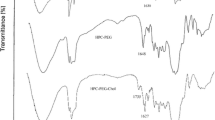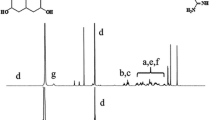Abstract
To ideally solve the contradiction between enhanced cellular uptake and prolonged blood circulation, reversible targeting polymeric micelles based on the expanding and shrinking behavior of a temperature-responsive polymer were developed. The micelle contained a hydrophobic PCL core and a mixed shell consisting of poly(N-isopropylacrylamide) (PNIPAAm) and biotin-terminated poly(ethylene glycol) (Biotin-PEG), and its targeting ability could be switched on/off by temperature. The cellular uptake of the complex polymeric micelles was studied. The results from a quantitative enzyme-linked immunosorbent assay (ELISA) indicated that the surface biotin content increased by as much as 11.6-fold when the temperature increased above the lower critical solution temperature (LCST). More importantly, the ELISA confirmed that biotin-mediated targeting on the surface was reversibly switched on and off for at least five cycles. In addition, the results from quantitative flow cytometry and confocal spectroscopy indicated that the cellular uptake of the targeted micelles at temperatures above the LCST was much higher than that at temperatures below the LCST. This complex polymeric micelle with reversible targeting property could be a promising alternative for drug delivery.









Similar content being viewed by others
References
Maeda H, Bharate GYY, Daruwalla J. Polymeric drugs for efficient tumor-targeted drug delivery based on EPR-effect. Eur J Pharm Biopharm. 2009;71:409–19. doi:10.1016/j.ejpb.2008.11.010.
Kwon IK, Lee SC, Han B, Park K. Analysis on the current status of targeted drug delivery to tumors. J Control Release. 2012;164:108–14. doi:10.1016/j.jconrel.2012.07.010.
Fang J, Nakamura H, Maeda H. The EPR effect: unique features of tumor blood vessels for drug delivery, factors involved, and limitations and augmentation of the effect. Adv Drug Deliv Rev. 2011;63:136–51. doi:10.1016/j.addr.2010.04.009.
Manuscript A, Targeting D, Heterogeneity T, Bae YH. Drug targeting and tumor heterogeneity. J Control Release. 2009;133:2–3. doi:10.1016/j.jconrel.2008.09.074.
Chen CC, Borden MA. The role of poly(ethylene glycol) brush architecture in complement activation on targeted microbubble surfaces. Biomaterials. 2011;32:6579–87. doi:10.1016/j.biomaterials.2011.05.027.
McNeeley KM, Karathanasis E, Annapragada AV, Bellamkonda RV. Masking and triggered unmasking of targeting ligands on nanocarriers to improve drug delivery to brain tumors. Biomaterials. 2009;30:3986–95. doi:10.1016/j.biomaterials.2009.04.012.
Gullotti E, Yeo Y. Extracellularly activated nanocarriers: a new paradigm of tumor targeted drug delivery. Mol Pharm. 2009;6:1041–51. doi:10.1021/mp900090z.
Low PS. The optimal strategy for drug targeting. Mol Pharm. 2007;4:629–30. doi:10.1021/mp700111w.
Fan N-C, Cheng F-Y, Ho JA, Yeh C-S. Photocontrolled targeted drug delivery: photocaged biologically active folic acid as a light-responsive tumor-targeting molecule. Angew Chem Int Ed Engl. 2012;51:8806–10. doi:10.1002/anie.201203339.
Chen Y, Gao D-Y, Huang L. In vivo delivery of miRNAs for cancer therapy: challenges and strategies. Adv Drug Deliv Rev. 2014;. doi:10.1016/j.addr.2014.05.009.
Niu Y, Yu M, Hartono SB, Yang J, Xu H, Zhang H, et al. Nanoparticles mimicking viral surface topography for enhanced cellular delivery. Adv Mater. 2013;25:6232–3. doi:10.1002/adma.201302737.
Yao X, Peng R, Ding J. Cell-material interactions revealed via material techniques of surface patterning. Adv Mater. 2013;25(37):5257–86. doi:10.1002/adma.201301762.
Poon Z, Chen S, Engler AC, Lee HI, Atas E, von Maltzahn G, et al. Ligand-clustered “patchy” nanoparticles for modulated cellular uptake and in vivo tumor targeting. Angew Chemie Int Ed. 2010;49:7266–70. doi:10.1002/anie.201003445.
Ashley CE, Carnes EC, Phillips GK, Padilla D, Durfee PN, Brown PA, et al. The targeted delivery of multicomponent cargos to cancer cells by nanoporous particle-supported lipid bilayers. Nat Mater. 2011;10:389–97. doi:10.1038/NMAT2992.
Kim C, Lee Y, Kim JS, Jeong JH, Park TG. Thermally triggered cellular uptake of quantum dots immobilized with poly(N-isopropylacrylamide) and cell penetrating peptide. Langmuir. 2010;26:14965–9. doi:10.1021/la102632m.
Moradi E, Vllasaliu D, Garnett M, Falcone F, Stolnik S. Ligand density and clustering effects on endocytosis of folate modified nanoparticles. RSC Adv. 2012;2:3025. doi:10.1039/c2ra01168a.
Sansone F, Casnati A. Multivalent glycocalixarenes for recognition of biological macromolecules: glycocalyx mimics capable of multitasking. Chem Soc Rev. 2013;42:4623–39. doi:10.1039/c2cs35437c.
Zhang Z, Ali MM, Eckert MA, Kang D-KD-K, Chen YY, Sender LS, et al. A polyvalent aptamer system for targeted drug delivery. Biomaterials. 2013;34:9728–35. doi:10.1016/j.biomaterials.2013.08.079.
Mastrotto F, Caliceti P, Amendola V, Bersani S, Magnusson JP, Meneghetti M, et al. Polymer control of ligand display on gold nanoparticles for multimodal switchable cell targeting. Chem Commun. 2011;47:9846–8. doi:10.1039/c1cc12654g.
Macewan SR, Chilkoti A. Digital switching of local arginine density in a genetically encoded self-assembled polypeptide nanoparticle controls cellular uptake. Nano Lett. 2012;12:3322–8. doi:10.1021/nl301529p.
Lin Q, Bao C, Yang Y, Liang Q, Zhang D, Cheng S, et al. Highly discriminating photorelease of anticancer drugs based on hypoxia activatable phototrigger conjugated chitosan nanoparticles. Adv Mater. 2013;25:1981–6. doi:10.1002/adma.201204455.
Borden MA, Zhang H, Gillies RJ, Dayton PA, Ferrara KW. A stimulus-responsive contrast agent for ultrasound molecular imaging. Biomaterials. 2008;29:597–606. doi:10.1016/j.biomaterials.2007.10.011.
Lee ES, Gao Z, Bae YH, Manuscript A. Recent progress in tumor pH targeting nanotechnology. J Control Release. 2008;132:164–70. doi:10.1016/j.jconrel.2008.05.003.
Sethuraman VA, Bae YH. TAT peptide-based micelle system for potential active targeting of anti-cancer agents to acidic solid tumors. J Control Release. 2007;118:216–24. doi:10.1016/j.jconrel.2006.12.008.
Quan C-Y, Chen J-X, Wang H-Y, Li C, Chang C, Zhang X, et al. Core-shell nanosized assemblies mediated by the alpha-beta cyclodextrin dimer with a tumor-triggered targeting property. ACS Nano. 2010;4:4211–9. doi:10.1021/nn100534q.
Gao H, Cheng T, Liu J, Liu J, Yang C, Chu L, et al. Self-regulated multifunctional collaboration of targeted nanocarriers for enhanced tumor therapy. Biomacromolecules. 2014;15:3634–42. doi:10.1021/bm5009348.
Tian Z, Yang C, Wang W, Yuan Z. Shieldable tumor targeting based on pH responsive self-assembly/disassembly of gold nanoparticles. ACS Appl Mater Interfaces. 2014;. doi:10.1021/am5045339.
Mok H, Bae KH, Ahn C-H, Park TG. PEGylated and MMP-2 specifically dePEGylated quantum dots: comparative evaluation of cellular uptake. Langmuir. 2009;25:1645–50. doi:10.1021/la803542v.
Deng C, Jiang Y, Cheng R, Meng F, Zhong Z. Biodegradable polymeric micelles for targeted and controlled anticancer drug delivery: promises, progress and prospects. Nano Today. 2012;7:467–80. doi:10.1016/j.nantod.2012.08.005.
Mura S, Nicolas J, Couvreur P. Stimuli-responsive nanocarriers for drug delivery. Nat Mater. 2013;12:991–1003. doi:10.1038/nmat3776.
Hildebrandt B, Wust P, Ahlers O, Dieing A, Sreenivasa G, Kerner T, et al. The cellular and molecular basis of hyperthermia. Crit Rev Oncol Hematol. 2002;43:33–56. doi:10.1016/s1040-8428(01)00179-2.
Mcdaniel JR, Macewan SR, Dewhirst M, Chilkoti A. Doxorubicin-conjugated chimeric polypeptide nanoparticles that respond to mild hyperthermia. J Control Release. 2012;159:362–7. doi:10.1016/j.jconrel.2012.02.030.
McDaniel JR, Dewhirst MW, Chilkoti A. Actively targeting solid tumours with thermoresponsive drug delivery systems that respond to mild hyperthermia. Int J Hyperth. 2013;29:501–10. doi:10.3109/02656736.2013.819999.
Miyata K, Christie RJ, Kataoka K. Polymeric micelles for nano-scale drug delivery. React Funct Polym. 2011;71:227–34. doi:10.1016/j.reactfunctpolym.2010.10.009.
Li C, Ge Z, Fang J, Liu S. Synthesis and self-assembly of coil–rod double hydrophilic diblock copolymer with dually responsive asymmetric centipede-shaped polymer brush as the rod segment. Macromolecules. 2009;42:2916–24. doi:10.1021/ma900165z.
Li W, Li J, Gao J, Li B, Xia Y, Meng Y, et al. The fine-tuning of thermosensitive and degradable polymer micelles for enhancing intracellular uptake and drug release in tumors. Biomaterials. 2011;32:3832–44. doi:10.1016/j.biomaterials.2011.01.075.
Akimoto J, Nakayama M, Sakai K, Okano T. Temperature-induced intracellular uptake of thermoresponsive polymeric micelles. Biomacromolecules. 2009;10:1331–6. doi:10.1021/bm900032r.
Sawant RM, Hurley JP, Salmaso S, Kale A, Tolcheva E, Levchenko TS, et al. “SMART” drug delivery systems: double-targeted pH-responsive pharmaceutical nanocarriers. Bioconjug. Chem. 2006;17:943–9. doi:10.1021/bc060080h.
Lee F, Chung JE, Kurisawa M. An injectable hyaluronic acid-tyramine hydrogel system for protein delivery. J Control Release. 2009;134:186–93. doi:10.1016/j.jconrel.2008.11.028.
Huang W, Wang W, Wang P, Tian Q, Zhang C, Wang C, et al. Glycyrrhetinic acid-modified poly(ethylene glycol)-b-poly(gamma-benzyl L-glutamate) micelles for liver targeting therapy. Acta Biomater. 2010;6:3927–35. doi:10.1016/j.actbio.2010.04.021.
Ho K, Lapitsky Y, Shi M, Shoichet MS. Tunable immunonanoparticle binding to cancer cells: thermodynamic analysis of targeted drug delivery vehicles. Soft Matter. 2009;5:1074. doi:10.1039/b814204a.
Glavas L, Olsén P, Odelius K, Albertsson AC. Achieving micelle control through core crystallinity. Biomacromolecules. 2013;14:4150–6. doi:10.1021/bm401312j.
Pulkkinen M, Pikkarainen J, Wirth T, Tarvainen T, Haapa-aho V, Korhonen H, et al. Three-step tumor targeting of paclitaxel using biotinylated PLA-PEG nanoparticles and avidin-biotin technology: formulation development and in vitro anticancer activity. Eur J Pharm Biopharm. 2008;70:66–74. doi:10.1016/j.ejpb.2008.04.018.
Liu X, Ma R, Shen J, Xu Y, An Y, Shi L. Controlled release of ionic drugs from complex micelles with charged channels. Biomacromolecules. 2012;13:1307–14. doi:10.1021/bm2018382.
Copolymers D, Li G, Shi L, Ma R, An Y, Huang N. Formation of complex micelles with double-responsive channels from self-assembly of two diblock copolymers. Angew Chemie. 2006;118:5081–4. doi:10.1002/ange.200600172.
Kataoka K, Harada A, Nagasaki Y. Block copolymer micelles for drug delivery: design, characterization and biological significance. Adv Drug Deliv Rev. 2001;47:113–31. doi:10.1016/s0169-409x(00)00124-1.
Simnick AJ, Amiram M, Liu W, Hanna G, Dewhirst MW, Kontos CD, et al. In vivo tumor targeting by a NGR-decorated micelle of a recombinant diblock copolypeptide. J Control Release. 2011;155:144–51. doi:10.1016/j.jconrel.2011.06.044.
Li G, Guo L, Ma S, Liu J. Complex micelles formed from two diblock copolymers for applications in controlled drug release. J Polym Sci A. 2009;47:1804–10. doi:10.1002/pola.23274.
Gao H, Xiong J, Cheng T, Liu JJ, Chu L, Ma R, et al. In vivo biodistribution of mixed shell micelles with tunable hydrophilic/hydrophobic surface. Biomacromolecules. 2013;14:460–7. doi:10.1021/bm301694t.
Huang Y, Jiang Y, Wang H, Wang J, Shin MC, Byun Y, et al. Curb challenges of the “Trojan Horse” approach: smart strategies in achieving effective yet safe cell-penetrating peptide-based drug delivery. Adv Drug Deliv Rev. 2013;65:1299–315. doi:10.1016/j.addr.2012.11.007.
Taghdisi SM, Lavaee P, Ramezani M, Abnous K. Reversible Targeting and controlled release delivery of daunorubicin to cancer cells by aptamer-wrapped carbon nanotubes. Eur J Pharm Biopharm. 2011;77:200–6. doi:10.1016/j.ejpb.2010.12.005.
Yellepeddi VK, Kumar A, Palakurthi S. Biotinylated poly(amido)amine (PAMAM) dendrimers as carriers for drug delivery to ovarian cancer cells in vitro. Anticancer Res 2009;29:2933–2943. http://www.ncbi.nlm.nih.gov/pubmed/19661298. Accessed 18 Apr 2014.
Yang W, Cheng Y, Xu T, Wang X, Wen L-P. Targeting cancer cells with biotin-dendrimer conjugates. Eur J Med Chem. 2009;44:862–8. doi:10.1016/j.ejmech.2008.04.021.
Quan C-Y, Wu D-Q, Chang C, Zhang G, Cheng S, Zhang X, et al. Synthesis of thermo-sensitive micellar aggregates self-assembled from biotinylated PNAS- b -PNIPAAm- b -PCL triblock copolymers for tumor targeting. J Phys Chem C. 2009;113:11262–7. doi:10.1021/jp902637n.
Cheng C, Wei H, Shi B-X, Cheng H, Li C, Gu Z-W, et al. Biotinylated thermoresponsive micelle self-assembled from double-hydrophilic block copolymer for drug delivery and tumor target. Biomaterials. 2008;29:497–505. doi:10.1016/j.biomaterials.2007.10.004.
Cheng C, Wei H, Zhang X-Z, Cheng S-X, Zhuo R-X. Thermo-triggered and biotinylated biotin-P(NIPAAm-co-HMAAm)-b-PMMA micelles for controlled drug release. J Biomed Mater Res A. 2009;88:814–22. doi:10.1002/jbm.a.31770.
Salmaso S, Caliceti P, Amendola V, Meneghetti M, Magnusson JP, Pasparakis G, et al. Cell up-take control of gold nanoparticles functionalized with a thermoresponsive polymer. J Mater Chem. 2009;19:1608. doi:10.1039/b816603j.
Abulateefeh SR, Spain SG, Thurecht KJ, Aylott JW, Chan WC, Garnett MC, et al. Enhanced uptake of nanoparticle drug carriers via a thermoresponsive shell enhances cytotoxicity in a cancer cell line. Biomater Sci. 2013;1:434. doi:10.1039/c2bm00184e.
Meyer DE, Shin BC, Kong GA, Dewhirst MW, Chilkoti A. Drug targeting using thermally responsive polymers and local hyperthermia. J Control Release. 2001;74:213–24. doi:10.1016/S0168-3659(01)00319-4.
Wu C, Han D, Chen T, Peng L, Zhu G, You M, et al. Building a multifunctional aptamer-based DNA nanoassembly for targeted cancer therapy. J Am Chem Soc. 2013;. doi:10.1021/ja4094617.
Tian Q, Zhang C-N, Wang X-H, Wang W, Huang W, Cha R-T, et al. chitosan/poly(ethylene glycol) nanoparticles for liver-targeted delivery. Biomaterials. 2010;31:4748–56. doi:10.1016/j.biomaterials.2010.02.042.
Zhang C, Wang W, Liu T, Wu Y, Guo H, Wang P, et al. Doxorubicin-loaded glycyrrhetinic acid-modified alginate nanoparticles for liver tumor chemotherapy. Biomaterials. 2012;33:2187–96. doi:10.1016/j.biomaterials.2011.11.045.
Macewan SR, Chilkoti A. Controlled apoptosis by a thermally toggled nanoscale amplifier of cellular uptake. Nano Lett. 2014;14:2058–64. doi:10.1021/nl5002313.
McDaniel JR, MacEwan SR, Li X, Radford DC, Landon CD, Dewhirst M, et al. Rational design of “heat seeking” drug loaded polypeptide nanoparticles that thermally target solid tumors. Nano Lett. 2014;14:2890–5. doi:10.1021/nl5009376.
Acknowledgments
This work was supported by the National Natural Science Foundation of China (51433004), Natural Science Foundation of Tianjin (13JCYBJC25100), and PCSIRT (IRT1257). We thank Prof. Deling Kong, Nankai University, for his help with the whole cell experiments.
Author information
Authors and Affiliations
Corresponding author
Rights and permissions
About this article
Cite this article
Wu, Y., Yang, C., Lai, Q. et al. Fabrication of thermo-sensitive complex micelles for reversible cell targeting. J Mater Sci: Mater Med 26, 255 (2015). https://doi.org/10.1007/s10856-015-5584-2
Received:
Accepted:
Published:
DOI: https://doi.org/10.1007/s10856-015-5584-2




